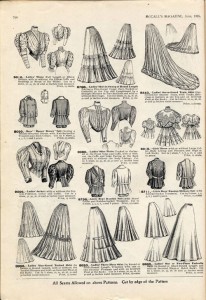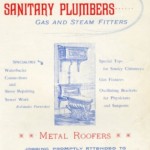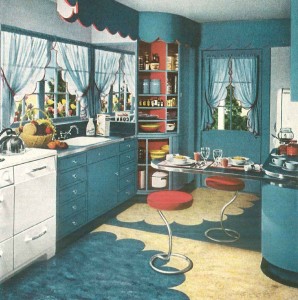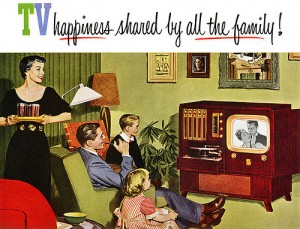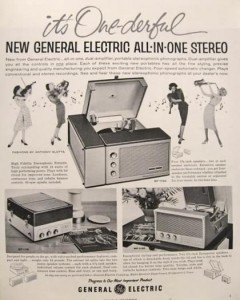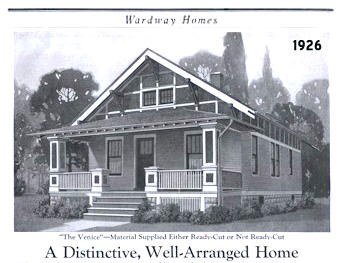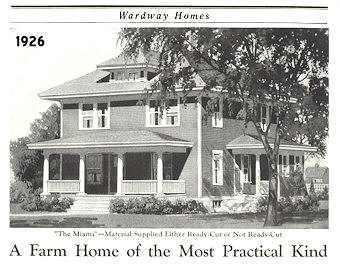Material Culture of the American Household
By Griffin Monahan
Introduction
This preliminary research project serves as a guide through material culture in the American household from the late eighteenth century continuing to the present. The study of material culture reveals great amounts of information into the daily lives of Americans. Consumerism’s influence in American culture places great significance on the individual items that occupy the American household. A grandfather clock in an eighteenth century parlor and a kitchen furnished with tupperware in the late twentieth century both can provide windows into the daily lives of past Americans. Items range in representations from status and wealth to a change in accepted gender roles. Understanding how Americans of the past lived and how current Americans live their lives exposes societal normalities as well as cultural shifts.
The guide is utilizes print sources, online collections, audio lectures, and museums to provide information on the topic of material culture in the American household. Beginning with a general background the guide continues with social connotations of material focusing on gender images, taste, and class. Information on specific materials such as the significance of a paper clip forms the following section. Educational sources on material culture serves as the conclusion of the guide providing databases of material culture on the American household.
Material Culture
The study of material culture combines archeology and social history. Material culture utilizes a micro-history approach to understand the past. By studying the significance of the parlor room in 18th century New England one can learn about the social forces of the time. Henry Glassie and Lorraine Daston explain material culture at a general level. Their works serve as a basic starting point for the study of material culture. In both works the authors explain why items hold certain power and how items come to such status.
- Glassie, Henry. Material Culture. Bloomington: Indiana University Press, 1999.
- Daston, Lorraine. Things That Talk: Object Lessons from Art and Science. New York: Zone Books, 2004.
Bill Brown a professor of English at the University of Chicago presents his “Thing Theory” in his work Things. His work provides an analytical look into the processes that surround material culture. Brown states his purpose of study of material culture on his faculty page from U. Chicago. “I’m asking how inanimate objects enable human subjects (individually and collectively) to form and transform themselves. How do individuals try to stabilize the ‘significance’ of their lives through the act of collecting? What role do objects play in the formation of gender, sexual, ethnic, and national subjectivity? How are subcultural formations (or projections of cultural form) mediated by objects?”
- Brown, Bill, ed. Things. Chicago: University of Chicago Press, 2004.
Dick Hebdige’s work Hiding in the Light: On Images and Things looks into popular culture images and the deeper meaning behind these images. Advertisements, photographs, and documentaries are analyzed revealing what hides in plain sight but often goes unrecognized. This book is an appropriate introduction into material culture because of the familiarity of the subject matter.
- Hebdige, Dick. Hiding in the Light: On Images and Things. London: Routledge, 1988.
Social Shifts
The creation, consumption, and use of objects ranging from dinner plates to doorframes are all included in the study of material culture. When studying the American home material culture frequently reflects social transitions. The development of a room can demonstrate the changing desire of the middle class and the popularity of Tupperware can reveal a change of gender roles. Material culture is of special importance in the study of American culture because of the overwhelming influence of consumerism. As groups of Americans changed over time so did the objects and items they interacted with. From the earliest American household material culture can illuminate revolutionary urges, changes in language , and the development of a uniquely American culture. James Deetz’s work The Archaeology of Early American Life, Expanded and Revised Edition provides great insight into the early American household.
- Deetz, James. In Small Things Forgotten: The Archaeology of Early American Life, Expanded and Revised Edition. New York: Anchor Books, 1996.
Gender Roles
One of the first major developments for women in America was the ability of young girls to leave the home to seek work. This process occurred early in New England with the introduction of mills and factories. Many of these mills had dormitories for the girls, the archeological report Living on the Boott: historical archaeology at the Boott mills boardinghouses, Lowell, Massachusetts describes the homes of mill girls. Dirty privies and combs designed for removing dirt from hair depict the dirty living conditions of the working girls. Young women could leave the house but they would not receive benefits or respect.
- Mrozowski, S. et al. Living on the Boott: Historical Archaeology at the Boott Mills Boardinghouses, Lowell, Massachusetts. Amherst: University of Massachusetts Press, 1996.
Towards the end of the 19th century young women began to receive more authority as their role changed once again. As women joined the work force more they began to desire an outlet from work other than home. Clubs, dance halls, picnic grounds, all developed for the purpose of entertaining young single women. New flamboyant dress expressed the sexuality of both men and women unseen before in public venues. Once women married they would fall back into the cult of domesticity and remain in the house. The family meal grew out of married women’s desire for control of their situations. The dining room and kitchen became images heavily associated with family and women. The sources below look into the leisurely activities of American women inside and outside of the home.
- Peiss, Kathy. Cheap Amusements: Working Women and Leisure in Turn-of-the Century New York. Philadelphia: Temple University Press, 1986.
- Goggin, Maureen D. and Tobin, Beth F. Women and the Material Culture of Needlework and Textiles, 1750-1950 . Burlington: Ashgate, 2009.
The American home presents a large, immobile structure to study in regards to material culture. The interior development of the household room by room reflects trends in society. Women developed overtime to become a part of the American kitchen. How did a room of the home become so gendered and how did women use the kitchen as a source of control? The Food Axis: Cooking, Eating, and the Architecture of American Houses and Kitchen Culture In America take an in depth look at the American home room by room with a special focus on the kitchen.
- Cromley, Elizabeth C. The Food Axis: Cooking, Eating, and the Architecture of American Houses. Charlottesville: University of Virginia Press, 2010.
- Inness, Sherrie A., ed. Kitchen Culture in America. Philadelphia: University of Pennsylvania Press, 2001.
Even through today American material culture plays a major role in defining gender. Everyday people interact, observe, and consume material culture it is quickly apparent how much influence material culture has on American society. The works below us contemporary examples of material culture to study how Americans define gender. Pat Kirkham a professor at The Bard Graduate Center: Decorative Arts, Design History, and Material Culture presents many interesting cases in her book The Gendered Object. She raises questions of what influence household objects as simple as dolls and neck ties have on our definition of gender. The work The Sex of Things uses economic, social, and art history to study how material culture interacts with gender roles over time. A section of the work focuses on the cosmetic boom of mid twentieth century American homes, the specificity of the section reveals the influence of a single household object on the American identity.
- Ames, Kenneth L. The Material Culture of Gender, The Gender of Material Culture.Hanover : University Press of New England, 1997
- Kirkham, Pat, ed. The Gendered Object. Manchester: Manchester University Press, 1996.
- de Grazia, Victoria, and Ellen Furlough, eds. The Sex of Things: Gender and Consumption in Historical Perspective. Berkeley: University of California Press, 1996.
Class Status
America unlike many other nation provides it citizens with the ability to move up the social rungs. Improving ones class status has always been associated with the American dream. Thorstein Veblen present his explanation of people’s desire to act like the upperclass in his book The Theory of the Leisure Class. This work provides a platform to begin with when studying the behaviors of middle class America.
- Veblen, Thorstein. The Theory of the Leisure Class. New York: Penguin, 1994.
Beginning in the 18th century the American home began to develop a unique room, the parlor. Low and middle class families began to incorporate parlors into their small, modest homes as an attempt to mirror the upper class. As the upper class changed their uses of the parlor from show piece, to museum, to family room so did the lower and middle class. Richard Bushman takes his readers through this process with great detail in his book The Refinement of America: Persons, Houses, Cities. His analysis of the American home clarifies values as the progressed with the changing home.
- Bushman, Richard. The Refinement of America: Persons, Houses, Cities. New York: Knopf, 1992.
Continuing with the progress of the American home into the 20th century Marina Moskowitz explores a new sensation of middle class America; the standard of living. A formal and informal definition, the standard of living quickly became interpreted by Americans as what a home should have. Home ownership, proper plumbing, and elegant kitchens all became associated with what Americans came to believe to be the standard of living.
- Moskowitz, Marina. The Standard of Living: The Measure of the Middle Class in Modern America. Baltimore: Johns Hopkins, 2004.
Jessica H. Foy and Thomas J. Sclereth also focus on the American home at the turn of the century with modernity as a theme. Their work looks into numerous components of the American home from the architecture to the new servies of the home such as gas heating, electronic stovetops, and plumbing. The analysis of the household objects and material culture exposes the behaviors of American society at the time.
- Foy, Jessica H., and Thomas J. Schlereth, eds. American Home Life, 1880-1930: A Social History of Spaces and Services. Knoxville: The University of Tennessee Press, 1992.
A major part of the American house has always been leisurely activities in the home. When working class men and women came home from work what would they do to relax? Hobbies influenced by material culture become especially promenant when answering this question. Steven M. Gelber’s book Hobbies: Leisure and the Culture of Work in America follows the progression of hobbies and leisure in the American household with examples of collecting dolls and woodcarving.
- Gelber, Steven M. Hobbies: Leisure and the Culture of Work in America. New York: Columbia University Press, 1999.
Style and Taste
The American home reflects the taste and style of the time. Decor, design, innovations, and appliances all are judged as aesthetically pleasing or ugly. Americans develop a sense of style and taste based on the world around them, advertisements, fashion, and quiet often their neighbors. To understand how people in general develop taste French sociologist Pierre Bourdieu enters the mind of the middle class in his book Distinction: A Social Critique of the Judgement of Taste. He probes as to why certain pieces of furniture or clothing become fashionable hits or ugly failures as determined by the middle class.
- Bourdieu,Pierre. Distinction: A Social Critique of the Judgement of Taste. Cambridge: Harvard University Press, 1984.
Pamela Simpson a professor of art history at Washington University and Lee University focuses on the construction of American and English homes in her book Cheap Quick & Easy: Imitative Architectural Materials. She investigates the social meanings of materials in the compositions of homes. Pseudo materials replaced expensive marbles and granites, Simpson attempts to answer what is the significance of the use of these materials. An interesting work she concludes that the new use of materials in the American home demonstrates values of modernity and democracy.
- Simpson,Pamela. Cheap Quick & Easy: Imitative Architectural Materials. Knoxville: University Tennessee Press, 1999.
In all societies those who initially set standards of taste and style are the upperclass. A great point of reference of luxury in America is A Treasury of Great American Houses. From the Vanderbilt mansion to grand plantations homesteads the work presents a collect of luxury in America from its youngest years to the 20th century.
- Williams, Henry Lionel. and Williams, Ottalick. A Treasury of Great American Houses. New York: Putnam, 1970.
When studying American material culture and the American home it is difficult to overlook the influence of the television. With its rapid entrance into the home during the 1950s the television became a fixture that brought the world of taste and style into the living room. For the first times fresh advertisements could enter the home visually with the flick of a switch. Karal Ann Marling provides a history of material culture from the most informal level; the comfort of the living room. Her study of material culture presents the thinking of middle class America during the middle of the 20th century.
- Marling, Karal Ann. As Seen on TV: The Visual Culture of Everyday Life in the 1950s. Cambridge: Harvard University Press, 1996.
Materials and Technology
Material culture uses a micro-approach to understand past culture and behavior. The specificity of the type of study and research lends itself to many single object studies. The following sources take specific objects and analyze their significance. American Artifacts: Essays in Material Culture and Material Culture in America: Understanding Everyday Life are collections of information on American material culture citing many household examples such as telephones, trading cards, and kitchenware.
- Prown,Jules David. and Haltman,Kenneth. American Artifacts: Essays in Material Culture. East Lansing: Michigan State University Press, 2000
- Wajda, Shirley. and Sheumaker, Helen. Material Culture in America: Understanding Everyday Life. ABC-CLIO, 2007
The 1960s were fueled with wild changes in the music industry. New business models, recording technology, and attitudes towards the influence of music changed the industry. The introduction of hi-fi stereo systems into the American household allowed for musicians to reach families like never before. Making Easy Listening: Material Culture and Postwar American Recording follows the progression of recording and the music industry in America.
- Anderson, Tim J, Making Easy Listening: Material Culture and Postwar American Recording. Minneapolis: University Of Minnesota Press,2006.
Decorative Arts and Household Furnishings in America, 1650-1920: An Annotated Bibliography serves as a series of analyses on many objects from the earliest day of America to the 20th century. Art, architecture, decor, and technology are all covered in the annotated bibliography. This work provides specific examples of material culture and their influence on the American people.
- Ames, Kenneth, and Gerald W.R. Ward, editors. Decorative Arts and Household Furnishings in America, 1650-1920: An Annotated Bibliography. Wilmington: Winterthur, Del: Henry Francis du Pont Winterthur Museum, 1989.
To understand the progression of the objects that occupy the daily lives of Americans Henry Petroski tells the tale of a paper clip. In his work The Evolution of Useful Things an extreme focus is placed on the most mundane objects that occupy the American home. Petroski answers the question of how these daily items came to be.
- Petroski, Henry. The Evolution of Useful Things. New York: Vintage, 1992.
Tupperware’s influence in mid 20th century suburban America demonstrates the power of material culture. From a simple idea to a revolutionary outlet for women Tupperware grew to become an icon. Alison J. Clarke brings her reader through the progression and growing influence in America. Tupperware grew to such a level that it allowed women to confront social, gender, and racial barriers.
- Clarke, Alison. Tupperware The Promise of Plastic In 1950s America. Washington DC: Smithsonian Institute, 1999.
Electronic Sources
While there is ample amounts of information on material culture and the American home in print there are also many quality electronic resources. Online collections of homes, online lectures, and entire university programs on material culture can all be easily accessed here.
Library of Congress: Material Culture
The Library of Congress has created a collection of American material culture focusing on folk art. The website focuses on folk material culture and vernacular architecture. Vernacular architecture is a category of material culture, in reference to the building styles of a culture. The study of vernacular architecture follows the different architectural styles that reflect the attitudes of the times.
The Material Culture of New York City
A New York Times online article present the history of New York City through 50 pieces of material culture. The objects ranges from all aspects of daily life in New York City. One of the most helpful pieces covers the development of the suburban house. William J. Levitt created a prototype suburban home that could be quickly and cheaply constructed. He saw the ensuing wave of white middle class American families leaving the city and seeking new suburban homes.
University of Delaware Program on Material Culture
University of Wisconsin-Madison on Material Culture
University of Wisconsin-Madison-Digital Library of Material Culture
Both the University of Delaware and the University of Wisconsin-Madison contain numerous resources on material culture. Each website provides collections, programs, and academic works on material culture.
University of Massachusetts Lowell Electronic Libraries
University of Massachusetts Lowell digital collection of elements of style. The website contains a series of galleries of paintings,photographs, and advertisements. The galleries follow the progress of the American household in both rural and urban settings during the 19th and 20th century. One of the galleries covers mail order homes of the early 20th century. Each advertised home reflects the values of America with captions noting practicality, elegance, and distinction.
The National Building Museum-Exhibit on the American Home
The National Building Museum’s exhibit on House & Home in America captures the development of the American home. The National Building Museum introduces the exhibit as “a kaleidoscopic array of photographs, objects, models, and films that takes us on a tour of houses both familiar and surprising, through past and present, challenging our ideas about what it means to be at home in America. Remarkable transformations in technology, laws, and consumer culture have brought about enormous change in American domestic life.” The interactive exhibit demonstrates the values associated with the materials used in the construction of homes and the significance of home ownership in America.
The Elements of Style: The Art of Fine Furniture-Making in America Then and Now
The Metropolitan Museum of Art offers a online lecture on furniture in America from the 17th century to the present. A scholarly discussion of many pieces of material culture from American homes. The discussion takes many angles as the furniture is analyzed from a business perspective, an artistic point of view, and a cultural interpretation.
Early American Material Culture
David Jaffee a professor of new media research at Brad Graduate Institution presents a short lecture on items from the early American home. He reviews the significance of paintings, globes, and furniture to middle class families of 19th century America.


